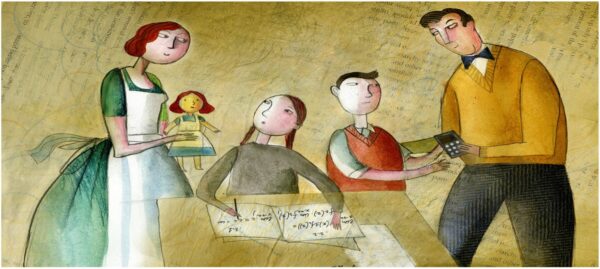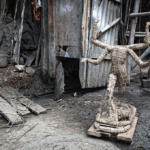The understanding of a “gender stereotype”
Gender stereotypes are defined as “a set of characteristics and traits that are automatically and rigidly attributed to members of the categories girls and boys”. They influence our thoughts, judgments, expectations and attitudes, and are more perceptible in mixed than in non-mixed environments.
More specifically, gender stereotypes refer to simplified descriptive categories of men and women, and therefore to the traits or behaviours that are arbitrarily attributed to these two sexes. These stereotypical beliefs about gender tell people not only what men and women are, but also how men and women should be and how they should behave.
Gender stereotypes legitimise judgements, evaluations and interpretations of men and women. They guide our behaviour and modify our relationships with others. They commit us to a practice and a relationship with others that does not require constant reflexivity but is based on previous references to the two sexes. In this sense, “they favour the irrational”.
Gendered ideology suggests that men and women are endowed with different skills, due to biological constraints or different ‘natures’. As a result, men and women are confined to roles dictated by their sex. Stereotyping also plays a part in accentuating the hierarchy between these two sexes. It should not be forgotten that the expression of a devaluation of an individual or group “corresponds to the sometimes non-explicit desire to overvalue another individual or group and vice versa”. They therefore legitimise and justify women’s situation of dependence, subordination and inequality in society.

Why we need to rethink gender stereotypes?
Sounds familiar? A woman’s place is in the home / men who show their emotions are not “real men” /women are better with raising children / men should never cry / mothers aren’t supposed to work / men are rational / women are physically and emotionally weak / the man is the family’s chief /women should obey their husbands etc. These stereotypical roles and perceptions give adult men and adolescent boys more power, more freedom and better access to resources. On the other hand, this would impede our opportunities for work, for study and for self-growth in general.
In fact, when it comes to leadership roles women are still underrepresented. The statistics reveal that “women hold just over a quarter of parliament seats and 22 % of ministerial positions”. Moreover, as stated by UN Women 2023, 11.3% of countries have women Heads of State (17 out of 151 countries, monarchy-based systems excluded), and 9.8% have women Heads of Government. In addition, women face limited options when applying for new job. A recent study indicates that interviewers would ask questions about marriage and fertility while men are rarely asked such questions. “When deciding on final employment, interviewers usually consider the high cost of women’s childbirth and refuse to hire”. According to a recent study, for job promotion, women and men with the same performances and tasks are generally evaluated differently. For example, female researchers working in the sciences are less likely to be promoted than male researchers, even though they have the same number of scholarly publications, research discoveries, etc. But people usually think that male researchers have more potential and are more suitable for researching deeper fields. Thus, no wonder women and men are still paid unequally. As reported by Gender Social Norms Index of 2023, the income gap between women and men reaches 39%.
Sociologists explain the harmful effects of gender stereotypes by stating that they are deeply rooted in power inequalities, dominance and subordination. In fact, values and norms about who can speak out or make decisions directly affect how power is distributed in society typically to the disadvantage of women and girls in particular. There is a social superiority of masculine values over those associated with the feminine. This is how dominant groups are formed, and how others are dominated by them. This domination is one of the foundations of society; it takes over the field of the symbols and of representations by reducing women to wives, sisters, daughters, mothers, etc.
The assertion of power and privilege by the society often entails violence directed at women and girls with grave consequences. As stated by Gender Social Norms Index report of 2023, 25% of people believe it is justified for a man to beat his wife. No wonder why gender based violence rates are increasing. The World Health Organization report of 2021 reveals that one in three women globally have already suffered physical and/or sexual intimate partner violence, non-partner sexual violence, or both. It also acknowledges that, globally speaking, 6% of women report that they have been subjected to sexual violence from someone other than their husband or partner.
The roots: the role of the society
Biological sex is socially constructed by the people who live in the society. By creating sex categories (male/female), the social world classifies the two sexes by assigning them so-called feminine or masculine characteristics and attributes. Thus, the differences between men and women are social and cultural, not biological constructs. In this respect, the dissemination of social norms and stereotypes plays a decisive role in the construction of masculinity and femininity.
In her book The Second Sex (1949), Simone De Beauvoir insisted on separating the woman from the mother. “One is not born a woman; one becomes one”. The author rejects the idea of nature and the universality of the feminine as a biological destiny. In other words, women are seen as reproductive organs. She went on to argue that femininity and motherhood are essentially social constructs and that every woman is first and foremost a human being and must be respected. De Beauvoir explains that “there is no biological, psychological or economic destiny that defines the figure that the human female assumes in society; it is civilisation as a whole that elaborates this intermediate product between the male and the castrate that we call feminine”. For De Beauvoir, the idea of nature has led to the oppression of women by men who seek to dominate them. And consequently served to subordinate them and relegate them to devalued tasks.
But it all starts earlier …

From birth and even before, children’s lives are already prescribed by their families. Bérénice Levet (2014) speaks of a trap that closes in on the individual. This happens when, during an ultrasound scan, the obstetrician announces: it’s a girl, it’s a boy you’re expecting. The doctor’s words then create a whole reality. Very early on, then, the child is labelled a boy or a girl and given characteristics that are supposed to be personal and considered feminine or masculine.
Family education, which is often gendered, is disseminated through family practices and projections that are strongly gendered and tend to reinforce differentiation between boys and girls. In this regard, Elena Gianini Belotti states that “the adult makes a veritable automatic selection of his or her interventions on the basis of sex”. Admittedly, parents try to define masculine and feminine by referring to knowledge they have received in the past. For example, “the way in which boys and girls are breastfed, nursed, carried, addressed, spoken to and interacted with differs according to gender”. From this perspective, parents are less tolerant of certain behaviours in girls, such as “shouting, talking too loudly or laughing too loudly, and forgetting to use polite language”.
In the toy department, parents tend to buy dolls, dinettes, household utensils and miniature sewing machines for little girls. For boys, on the other hand, they buy figurines, mechanical toys (cars, aeroplanes, railways) and electronic toys “that develop other skills than the ability to carry out domestic tasks”. Girls’ toys are generally associated with domestic activities, motherhood, seduction (beauty accessories and princess costumes), and caring for and serving others (nurse’s outfits). Boys are introduced to toys that articulate warrior heroism or adventure. In this respect, Bernard Lahire asserts that education through toys tends to construct “tacit or semi-explicit divisions of differentiated territories”: boys outside and girls inside. This subsequently engenders a gendered division of labour and knowledge in adult life.
Also read: Dimensions of Water Marginality and Hydro-Politics in India
Parents also tend to indicate their children’s gender through external signs. The fact that certain items of clothing are reserved for one of the sexes (dresses for girls and shorts for boys), or the assignment of colours to the sexes (pink for girls and blue for boys) “play a major role in the construction of gender from birth to death“. Parents feel a strong need (to cut a boy’s hair from a very early age so that he is not seen as a girl.
As far as parental projections are concerned, adults tend to describe to their children what is appropriate for their genders. According to Sylvie Octobre, parents of girls dream of swimming, dancing, music or horse riding.
Family projections also involve gendered comments. From the moment little babies are born, parents use terms differentiated according to their sex: tall for sons and beautiful, cute, kind or small for daughters. Identification also plays a central role in the development of a child’s identity. Those around them inculcate in them models that they are invited to conform to. This process initially takes place within the family. Observation of parents certainly contributes to the construction of the feminine and masculine, such as the division of responsibilities within the family “and through the cultural behavioural models of each of them“. The children observe a certain division of labour between the parents; fathers often work, while mothers look after the children and do the housework. In this placement, we can talk about a manifestation of stereotypes in their regard. The father is perceived as superior while the mother is inferior, especially as family legislation generally gives the husband the title of ‘head of the family’ and assigns him the role of wage earner.
References:
Bouvier Mollo Suzane, Medina Pozo Yvonne (1991), Discrimination and human rights in teaching materials, methodological guide, Education studies and documentations, France, Unesco.
Duru-Bellat Marie (2008), ” The representation of gender relations: what place for the school institution “, Travail genre et société, n°19, p131-149.
Hurtig Marie Claude, ” The socialised elaboration of the difference between the sexes “, Enfance, n°4, 1982,p 283-301.
Guionnet Christine, Neveu Erik (2014), Feminin/masculin: sociology of gender, Paris, Armand Colin.
Lahire Bernard (2010), ” Family transmission of the unequal order of things “, Regards croisés sur l’économie, n° 7, p 203-210.
Mosconi Nicole (2004), ” Effects and limits of mixed schooling “, Work, gender and societies, n° 11, p 165-174.
Mosconi Nicole (2016), From Belief to Gender Difference, Paris, L’Harmattan
Michel Andrée (1986), No to stereotypes! Overcoming sexism in children’s books and school textbooks, Paris , UNESCO
Octobre Sylvie (2010), ” The cultural socialisation of children within the family “, Cahiers du genre, n°49, p55-71
Grange Juliette (2010), ” Gender and sex: new epistemological categories in the human sciences “, Cités, n°44, p107-121.
UNDP (2024), “Gender social norms index Breaking Down Gender Biases”
Rachel D. Godsil et al (2016), “The effects of gender roles, implicit bias, and stereotype threat on the lives of women and girls” The science of equality, volume 2
Xinye Ye (2023), “The Impact of Gender Stereotypes on Women in the Workplace”, Communications in Humanities Research, n°13, volume 1
Levet Bérénice, Onfray Michel (2014), The theory of gender or the dream world of angels: gendered identity as a curse, Paris, Grasset.
De BeauvoirSimone (1949), The Second Sex, I, Paris, Gallimard

About the author …
Yasmine Jallow is a Tunisian PhD student and a researcher in gender studies and political sciences at the Faculty of Law and Political Sciences of Sousse. She mainly works on deconstructing gender norms and stereotypes in the Tunisian society. An intersectional feminist and a climate change activist, her advocacy for women’s rights and climate change issues are priorities for her. She recently worked on drafting a policy brief to defend Tunisian rural women who are affected by the climate crisis. She also conducts awareness workshops on gender issues.











Very interesting article. Gender worldwide is a weapon by which most women are eliminated in the first place without any evaluation of their works or thoughts.
Well done and keep on going.
Well done